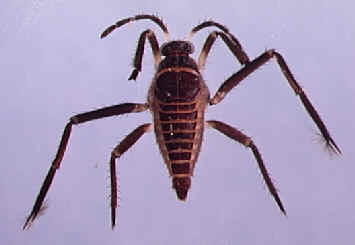Disclaimer & Copyright Notices; Optimized for the MS Internet Explorer
(True bugs)
Soil & Water Conservation Society of Metro Halifax (SWCSMH)

Updated: October 09, 2013 

Contents:
- Superphylum Arthropoda
- (jointed-legged metazoan animals [Gr, arthron = joint; pous = foot])
- Phylum Entoma
- Subphylum Uniramia
- (L, unus = one; ramus = branch, referring to the unbranched nature of the appendages)
- Superclass Hexapoda
- (Gr, hex = six, pous = foot)
- Class Insecta
- (L, insectum meaning cut into sections)
- Subclass Ptilota
- Infraclass Neopterygota
Introduction
This is a large order of neopterygote
insects, that includes both the Heteroptera and the Homoptera (the
"true bugs). Species range in size from 1 mm to 9 cm and,
characteristically, they have mouthparts adapted for piercing and
sucking the fluids from plants or animals. All of the Homoptera are
terrestrial and none is carnivorous. Worldwide, there are about 3,200
species of hydrophilic Heteroptera.
Hemiptera, or true bugs, belong
to the infraclass Neoptera. division Exopterygota; their wings develop
externally and can be folded over the dorsum. Only about 10% of all
species of Hemiptera are associated with water, and these are
representatives of 15 families of the suborder Heteroptera, 14 of which
occur in northeastern North America.
Apart from a few aphids living on the
aerial parts of water plants, the Hemiptera associated with water
belong to two series of Heteroptera: the Nepomorpha, which when truly
aquatic spend most of their time under water, and the Gerromorpha,
which are primarily adapted to live on water surfaces.
Life History
Hemipterans are paurometabolous, undergoing
incomplete, gradual metamorphosis from egg to nymph to adult. Eggs
hatch after one to four weeks of embryonic development, then the nymphs
undergo 5 molts before molting to the sexually mature adults.
Hemipterans generally overwinter as adults, and in regions where ponds
freeze many species fly to streams to overwinter. In temperate regions,
life cycles are usually univoltine, or occasionally bivoltine, with
reproduction occurring in the summer. Multivoltinism is more common in
the tropics.
In common with other
hemimetabolous insects (no pupal stage), the nymphs are very similar to
the adults in terms of their appearance, habitat and behaviour, but are
smaller.
Nepomorpha
The Nepomorpha are divided into four superfamilies.
- The Nepoidea contains the water
scorpions and water stick insects of the family Nepidae and the giant
water bugs, electric light bugs, and toe biters of the Belostomatidae;
the genus Lethocerus contains the largest Heteroptera and the largest aquatic insects.
- The Naucoroidea, with a single family, the Naucoridae, are oval flat water bugs most often found in running water.
- The Notonectoidea consist of three families of backswimmers: Notonectidae, Pleidae, and Helotrephidae.
- The Notonectidae are divided into two subfamilies, Notonectinae and Anisopinae.
- The former contains three tribes. In the Notonectini the largely temperate and Neotropical Notonecta and the largely paleotropical Enithares include nearly all the large species of the family, while the Nychiini are small, like most Anisops and Buenoa in the Anisopinae.
- Notonecta contains five subgenera. Of these, Notonecta
s. str. is primarily Palearctic with two Nearctic species, two of the
other subgenera are western in the New World, and a fourth is
Australian. The fifth subgenus, Paranecta, is largely New World with species in eastern Asia.
Notonecta feeds on almost any animal food that is available,
though occasionally specific prey may be rejected. Mosquito larvae are
clearly important, as are insects that have fallen on the surface. It
is commonly believed that many adults pass the winter buried in mud,
and this has been well documented in the case of Notonecta (Paranecta) undulata
in western Canada. Migrations, notably from large bodies of water to
small breeding pools in the spring, are clearly of considerable
importance in cool temperate regions.
- The western New World Erythronecta probably contains the brightest-colored freshwater insects.
- The Nychiini are very little known ecologically and are mainly found in running water.
- The Anisopinae consist of two species of Paranisops in Australia, about 130 species of Anisops in the warm temperate and tropical zones of the Old World and 45 Buenoa in the temperate and tropical New World.
- The Pleidae consist of a few genera of very cloely allied backsimmers not over 3 mm long and generally smaller.
- The Helotrephidae are
another family of minute water bugs. They consist of two subfamilies,
the Helotrephinae, seeming to live like the Pleidae in tropical
latitudes, and the Idiocorinae with two species in different genera.
- The Corixoidea contain a
single living family, the Corixidae, divded into six subfamilies, the
primitive Australasian Diaprepocorinae, the very widespread
Micronectinae, the Cymatiinae, the Stenocorixinae, the Heterocorixinae,
and the Corixinae.
Most species of Corixidae live in quite shallow water, though in
cold temperate regions they evidently cannot inhabit in winter small
pools that freeze solid, a fact of significance to their distribution.
Very large migratory flights of Corixidae have sometimes been observed,
and for many species migration is clearly a regular event in the life
history, winter being spent in larger, deeper bodies of water than are
used as breeding grounds. The Corixidae in general show a considerable
variation in their pigmentation, which is correlated with the albedo of
the background on which they are living.
- The Corixinae are rarely under 5 mm and often over 10 mm long. They
are clearly better developed in cool temperate regions than in tropical
ones; in North America any one area may have a pool of over 40 species.
Habitat
Hemipterans are generally found in lentic
habitats or in backwater or pool areas of streams to which they may
have flown to overwinter. Hemipterans are found in three general
habitats.
- Six families are fully aquatic in all
life history stages (true water bugs: Belostomatidae, Corixidae,
Naucoridae, Nepidae, Notonectidae, and Pleidae). These families are
classified as swimmers, clingers, or climbers. Two of them
(Notonectidae and Pleidae) swim upside down (venter up) and have been
given the common name, backswimmers.
- Four families are surface dwellers or skaters (Gerridae, Hydrometridae, Mesoveliidae, and Veliidae) and are thus semiaquatic.
- Four families are shore bugs and live along the edges of ponds or
streams. Gelastocoridae, Hebridae, Ochteridae, and Saldidae contain
species classified as skaters, climbers, clingers, burrowers, or
sprawlers.
Families within the suborder Heteroptera that are associated with water and their habitat (Williams & Feltmate, 1992)
| Family | Habitat |
| Infraorder Leptopodomorpha |
| Saldidae | (shore bugs)- margins of streams & ponds |
| Infraorder Gerromorpha |
| Mesoveliidae | (water treaders)- vegetated banks of ponds & lakes |
| Macroveliidae | (shore bugs)- stream margins |
| Gerridae | (water striders)- surface of fresh & brackish waters (sea) |
| Veliidae | (riffle bugs)- surface of ponds & streams, also brackish |
| Hydrometridae | (water measurers)- surface of calm waters |
| Hebridae | (velvet water bugs)- marshes & wet riparian mosses |
| Infraorder Nepomorpha |
| Nepidae | (water scorpions)- ponds, on vegetation |
| Belostomatidae | (giant water bugs)- ponds, in vegetation |
| Corixidae | (water boatmen)- fresh & brackish lentic waters |
| Notonectidae | (backswimmers)- ponds and lakes |
| Naucoridae | (creeping water bugs)- lentic & lotic, stones & vegetation |
| Ochteridae | (shore bugs)- stream margins, pond vegetation |
| Gelastocoridae | (toad bugs)- shorelines, in mud & plant debris |
| Pleidae | (pygmy backswimmers)- ponds & lakes, in vegetation |
| Helotrephidae | ponds & lakes, in vegetation |
Feeding
Adult and nymphal hemipterans are
predaceous, having mouthparts specialized for piercing and sucking the
contents of their prey. They prey on a variety of aquatic insects and
crustaceans. There are even accounts of large aquatic hemipterans
consuming vertebrates; for example, a Lethocerus americanus attacking a woodpecker, an L. uhleri
feeding on a 30-cm-long banded water snake! Giant water bugs can be
important pests in fish hatcheries, since they feed on fish up to 7.5
cm long.
Indicator value
The ecology of the aquatic Hemiptera is much
better known, and it is probable that they are limnologically more
significant than the beetles. (Hutchinson, 1993)
Most hemipterans are either lentic
or slow water lotic forms. They are all air breathers and as such are
more tolerant of environmental extremes than most other insects. The
water boatman, Hesperocorixa, and the water strider, Gerris,
are among the few insects that can tolerate pH values less than 4.5 and
are among the last to disappear when lakes and streams acidify.
Of all aquatic organisms, the giant water bug, Belostoma fluminea,
is considered by many to be among the most tolerant of extreme
conditions, high chloride, high BOD, low oxygen, low pH, etc. However,
it like all hemipterans, has little or no indicator value because their
life does not depend entirely on water quality. (Mackie, 2001)
References and web URLs:
- Hutchinson, G.E. 1993. A Treatise on Limnology. Vol. IV, The Zoobenthos. Ed. Y.H. Edmondson. John Wiley & Sons, Inc. Xx, 944pp.
- Mackie, G.L. 2001. Applied Aquatic Ecosystem Concepts. Kendall/Hunt Publishing Company. xxv, 744 pp. ISBN 0-7872-7490-9
- Narf, R. 1997. Midges, bugs, whirligigs and others: The
distribution of insects in Lake "U-Name-It". Lakeline. N. Am. Lake
Manage. Soc. 16-17, 57-62.
- Peckarsky, B.L., P.R. Fraissinet, M.A. Penton, and D.J. Conklin,
Jr. 1990. Freshwater Macroinvertebrates of Northeastern North America.
Cornell Univ. Press. xii, 442pp.
- Wetzel, R.G. 1983. Limnology. 2nd ed. Saunders College Publishing. Xii, 767pp, R81, I10.
- Williams, D.D., and Feltmate, B.W. 1992. Aquatic Insects. CAB International. ISBN: 0-85198-782-6. xiii, 358p.
"Sounds provided by and copyrighted to Naturesongs.com, 1997-2004"


We salute the Chebucto Community Net (CCN) of Halifax, Nova Scotia, Canada for hosting our web site, and we applaud its volunteers for their devotion in making `CCN' the best community net in the world
